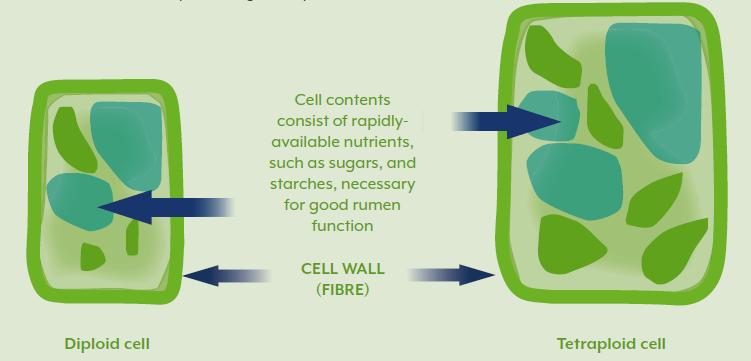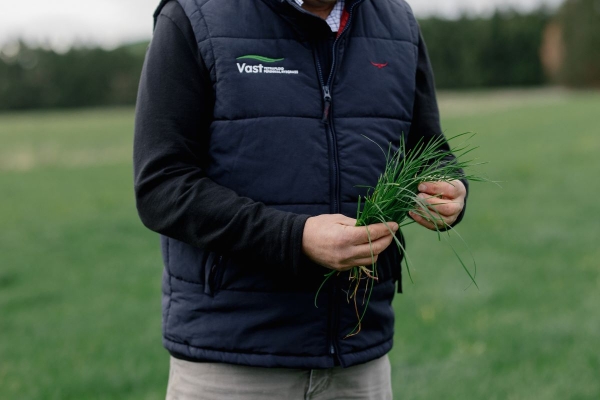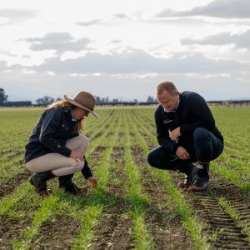Diploid Vs Tetraploid Ryegrasses
Diploid ryegrass
Diploid ryegrasses have two sets of chromosomes per cell compared to a tetraploid, which has four. Diploids combine yield and robustness, meaning that even in less than ideal conditions, they are more likely to deliver for your stock.
Dependable diploids
- Densely-tillered
- Good robustness and versatility
- Competitive with weeds
- Persistence in lower soil fertility
- Ideal for grass to grass situations
- Can handle wetter environments
- Able to be set stocked or rotationally grazed
PGG Wrightson Seeds diploid breeding programme
Delivering New Zealand bred and trialled ryegrasses that you and your stock can depend on:
- Excess perennial ryegrass
- Rely perennial ryegrass
- Platform perennial ryegrass#
- Expo perennial ryegrass
- Maverick GII short rotation ryegrass
- Supercruise Italian ryegrass
Tetraploid ryegrass
Intensive farming systems require ryegrasses that produce bulk, high quality feed to drive animal performance and productivity. Tetraploid cultivars are a significant tool in helping achieve this goal, being naturally high in water soluble carbohydrates (sugars). A tetraploid plant has four sets of chromosomes per cell (a diploid has two sets), which simply means tetraploid ryegrasses are more palatable for livestock. Animals prefer tetraploids over diploids if they have a choice and often graze tetraploid ryerass more quickly and evenly.
Tasty tetraploids
- Fast to establish
- Excellent palatability leading to good pasture utilisation by grazing animals
- Very high quality pasture
- Higher dry matter intakes leading to improved animal performance
- Great for silage quality
- Great clover compatibility
Tetraploid breeding programme
PGG Wrightson Seeds internationally-acclaimed tetraploid breeding programme – delivering New Zealand bred and trialled tetraploid
- Vast tetraloid perennial ryegrass
- Base tetraploid perennial ryegrass
- Delish® tetraploid short rotation grass
- Lush tetraploid Italian ryegrass
- Feast®II tetraploid Italian ryegrass
- Winter Star II tetraploid annual ryegrass
PGG Wrightson Seeds are specialists in tetraploid technology; breeding market-leading cultivars since 1989. We offer a tetraploid portfolio including annual, Italian, short rotation and perennial ryegrasses with a range of endophyte options. These cultivars have built an impressive reputation with New Zealand farmers, due to their palatability, resilience and animal performance benefits.
Animal performance benefits
- Improved palatability and intake – greater intake can lead to increased production and/or improved body condition
- More efficient rumen function – tetraploid ryegrasses can be broken down more quickly and completely in the rumen, due to the high ratio of cell contents to cell wall
- More clover – tetraploid ryegrass allows about 10% more clover in the pasture mix, further increasing pasture quality and animal performance
Farm management benefits
- Improved pasture utilisation – improved palatability means more grass is utilised. This can lead to easier pasture management by reduced topping requirements, less seed head development and improved animal performance
- Reduced stocking rates – improved palatability means greater intake and production per head and the potential to reduce stocking rates. A lower stocking rate may mean a reduction in farm costs (e.g. mating, vet costs)
Grazing management tips
- Avoid persistent overgrazing – the excellent palatability of tetrapolids can easily result in pastures being overgrazed. Monitor post-grazing residuals to avoid these getting too low and comprising ryegrass persistence
- Apply nitrogen as normal – tetraploid ryegrasses are naturally a darker green than diploids, but still require similar amounts of nitrogen




